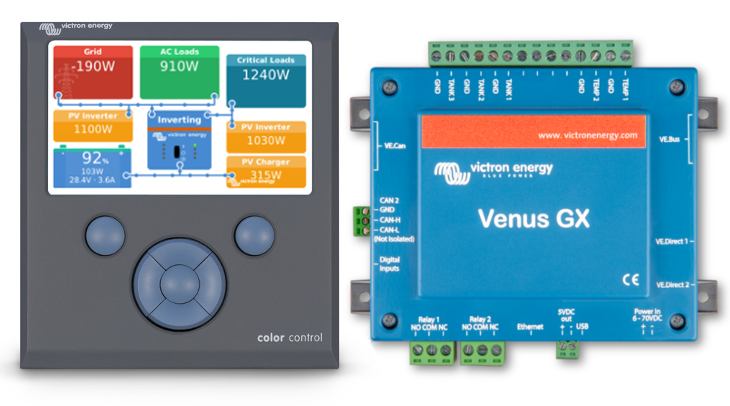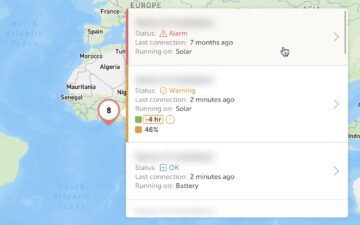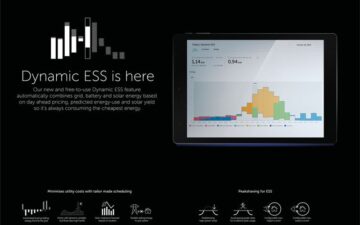
Good morning,
Today we are releasing version 2.23 of Venus OS – the software which is at the heart of the Color Control GX, Venus GX, Octo GX and the CANvu GX. A nice page outlining those products and comparing them is available here. Also we will release VE.Bus version 455 today, for the MultiGrid and MultiPlus-II inverter/charger models.
Included in this update are various improvements; including that the user interface will not show details of VE.Bus Error 11.
VE.Bus Error 11
This error only applies to the MultiGrid and MultiPlus-II models: the inverter/chargers with a dual backfeed relay. For ESS systems, a grid-code is selected in VEConfigure, and then as part of grid-code compliance; the device verifies that its internal relays and measurement circuitry functions properly. When this test fails; Error 11 shows. Quite often, the error can be tracked down to an installation error (swapped Phase and Neutral wiring for example), but there were also some software issues; and the details of Error 11 not being visible was not helping. Today we are taking care of all that. A short list of related firmware releases:
- VE.Bus firmware 454 – February 8th – Adds detailed Error 11 reporting.
- Venus OS v2.23 – today – Adds detailed Error 11 reporting.
- VE.Bus firmware 455 – today – Fix false Error 11 of the type “AC0/AC1 mismatch” and “UMains error”.
Conclusion: if you have a VE.Bus Error 11 and have already double-checked the wiring, then update all to the firmware released today; which is likely to solve the issue. And if it doesn’t – then at least you will have far more information to help you resolve it.
Full changelog
General:
- Fix that changing the date & time did not work properly for off-grid systems: changes to the date and time were only stored to the device when being rebooted from within the menus (which nobody ever does). Power cycling a unit would make it jump back to the previous date & time. This is now fixed. Note that only installations without internet were affected: with internet, the date and time are set automatically; as well as stored properly. This bug has always been in the system, since the first release.
- Update Eastern Europe time zones; fixes issues with Romania and other countries
- Add a low-cell voltage warning and alarm for Lynx Ion BMS systems. Note that this warning and alarm is only available for systems with a Lynx Ion BMS. Not for the (discontinued) Lynx Ion + Shunt models; and also not for any other (CAN-bus connected) battery types. How does it work? It will first issue a warning; and that will change to an alarm once the voltage is so low that the system has disabled the ‘allow-to-discharge’ signal; which shuts down any connected inverters and other loads.
- Fix internet connection issues for a small number of systems; by lowering the MTU to 1450. If affected you typically see that logging data to the VRM works, but Remote Console does not work; and Remote VEConfigure and Remote Firmware Update work partially: scanning typically works; but anything using full packet sizes; such as uploading a firmware file; or transferring the VEConfigure file; does not work and returns error 1300. More information here: https://community.victronenergy.com/questions/3608/how-to-solve-error-1300-on-remote-ve-configure.html
- Fix VE.Bus Low Battery, Overload and Temperature warnings and alarms showing up twice in the menu and notifications (bug was introduced in v2.18)
- Fix vup-error-9 on VRM Remote Firmware system. The error in itself was harmless; but raising questions.
- Debounce VE.Bus warnings: warnings now stay valid for at least 20 seconds in order to reduce the number of warning -> ok -> warning changes; notifications and VRM emails.
- Add the names of various new VE.Bus inverter/chargers
ESS:
- Fix bug in Scheduled charging that failed to make optimal use of the PV when in the scheduled charging window.
- When Active AC input is a generator, enable the Fronius zero-feedin limiter. Thanks to Simon Hackett for reporting.
- For systems with CAN-bus BMS batteries, MPPT Solar Chargers, and DVCC enabled, the use of PV power in systems with a relatively small batteries has been improved. An example to illustrate it: lets say the battery indicates a discharge limit of 25A. And at the same time, there is 40A of solar available from the solar charger. In the old situation; the maximum draw from the DC bus would be 25A = 1250 W. Net result for the battery would be that it was being charged with 40 – 25 = 15 Ampere. With v2.23 installed, it will allow up to 65 A draw from the DC: 25A from the battery, and 40A from the solar charger.
Venus GX:
- Improve flexibility of the multiplier setting for the pulse counter; the spinbox has been replaced with a normal edit box where a number can be entered now; with up to 6 decimal places. (thank you Greg for helping with this)
ModbusTCP:
- Make battery relay writeable, i.e. Lynx Shunt (thanks Shane)
- Add registers related to charge current and temperature alarms.
- Add register for LowCellVoltage alarm & warning sent by the Lynx BMS
- Add register for Battery Temperature on VE.Bus devices.
- Add register for VE.Bus system reset; same function as in the inverter/charger menu in the Device List.
And then there are a few more improvements, enhancing system stability and robustness.
For those who were hoping to find the Marine MFD chartplotter integration, as explained here in a blog, I have to disappoint you, it’s not ready yet; so not in this release. We can report good progress on that project though; and I still expect to release it at the end of this quarter for Navico and Garmin. As mentioned during the announcement, Raymarine will follow a bit later.
How to update?
You can find information about how to install the new version of Venus OS here. For the full changelog, visit Victron Professional.
In conclusion, I wish you a good day!
Matthijs Vader


















 #victronenergy #adventure
#victronenergy #adventure
 ELECTRICS
ELECTRICS 
